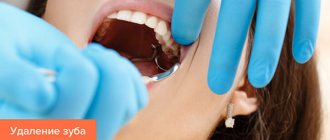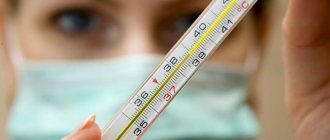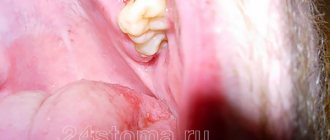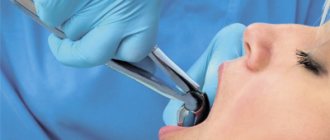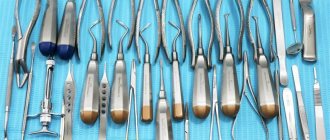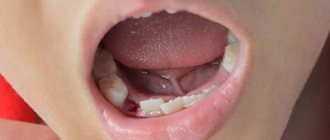After your tooth was removed, the doctor gave you clear instructions and recommendations on what to do and what not to do. But you came home and in the confusion forgot what the doctor said?
We will try to help you and answer the most common questions that a patient has after tooth extraction.
- How quickly does a wound heal after tooth extraction?
- What complications can occur after tooth extraction?
- How long should you keep the tampon in after tooth extraction?
- How to rinse your mouth after tooth extraction?
- What recommendations should be followed after tooth extraction?
- In what case should you urgently consult a doctor after tooth extraction?
What recommendations should be followed after tooth extraction?
- Do not eat food for two hours after surgery.
- Do not spit out blood clots during the day, as their absence can lead to exposure of the wound, which will negatively affect the healing process. Experts recommend swallowing saliva, even if it contains a small percentage of blood.
- To make the swelling go away faster, the patient can apply cold compresses to the site of the extracted tooth, but with caution so as not to get frostbite. The use of any warming compresses and scarves is prohibited!
- Refuse hot food and give preference to warm food, including drinks. You should also avoid spicy, sour and fatty foods for 1 week.
- Under no circumstances should you chew food at the site of the extracted tooth .
- Avoid drinking alcohol and smoking for the first two days.
- Do not apply medications to the wound or rinse the mouth with tinctures containing alcohol.
- Avoid any physical activity for two weeks.
- Do not touch the hole with your hands or foreign objects!
- Do not visit saunas and steam baths for a week.
About the medicine
The medicine that is placed in the hole can be applied to a piece of gauze, which is subsequently inserted into the hole. In this case, after a certain amount of time indicated by the doctor, it needs to be taken out. This can be done either independently or during your next visit to the dentist. If this is not done in time, the process of putrefaction may begin, which will greatly complicate the situation. It is also not recommended to take out the gauze ahead of time, since food particles can get into the hole and the tongue can touch it, which will interrupt the healing process and also cause complications.
There is another way to install the medicine - in a hemostatic sponge. It already contains a medicine that helps disinfect the socket cavity and helps stop bleeding. You cannot take this sponge out - it will dissolve on its own. Most often this happens within 1-2 days, but in some cases the sponge may remain in the hole for 5-6 days. There is no need to be afraid of this. As a last resort, you can consult a doctor who will examine the wound and determine whether healing is proceeding normally.
Often the medicine in the sponge is very bitter, and this causes severe discomfort to the person. Unfortunately, nothing can be done about this, since getting rid of the sponge ahead of time is strictly contraindicated. To eliminate bitterness, you can drink sweet tea or juice.
Remember ! No circumstances can influence the ability to remove the medicine from the hole ahead of time. After 3-4 days, the surface of the hole will heal, and you will no longer have to experience discomfort.
People often wonder what kind of medicine is used for these purposes. Sometimes the gauze that is placed in the hole is treated with iodine - this will both disinfect the wound and prevent bleeding. The hemostatic sponge is already treated with a special substance consisting of boric acid, collagen and nitrofural, which helps stop the bleeding and protect the hole from various influences. But most often dentists use Alvozhil.
No other means are used for inserting into the hole.
Manufacturing
To make a turunda, sterile gauze wipes, screws, and cotton wool are used. It is important to observe the proportions of dilution of the impregnation product and the choice of composition. For preparation, medicinal ether is used in the proportion of ten parts of ether to one part of iodoform.
The finished solution is not stored; it quickly loses its properties. therefore, the doctor makes the amount that will be sufficient for use during one appointment.
To make turunda, a piece of gauze is cut into thin ribbons. The length of each depends on the characteristics of the hole; impregnation is carried out before use. Additional medications are used if an anti-inflammatory, therapeutic effect is required.
Types of dressing material in dentistry
The following are widely used in dentistry:
- Absorbent cotton wool is used in therapeutic dentistry to dry the patient’s oral cavity during treatment. Cotton rolls are formed by twisting the material onto the handle of any dental instrument.
- White gauze is used to make napkins, balls, and strips for tamponade. The main condition is that the edges of the gauze are folded into the middle - this prevents fibers from getting into the wound. Used as a drying material for wounds.
The dressing material must be sterilized before use.
Taking antibiotics after the procedure
Dentists quite often resort to antibiotics in the postoperative period, especially after tooth extraction. But not every patient who has undergone tooth extraction requires antibiotics. They are prescribed only in the following cases:
- if the patient experiences inflammatory processes in the gum area;
- if the patient is elderly;
- if complications arise during the operation or features of the anatomy of the teeth are revealed, which contributes to more extensive trauma;
- if the patient has a reduced immune system or suffers from any blood diseases.
This list is not all of the reasons for prescribing antibiotics in the postoperative period, because each individual case has its own characteristics. An experienced dentist will be able to easily determine which patient needs to take medications after tooth extraction. The doctor must determine the duration of administration and dose individually for each case. Most often, the course of taking the drug after tooth extraction lasts from five to seven days. In rare complicated cases, treatment can last up to fifteen days. It is simply impossible to determine the average dose of antibiotics that is needed, since each individual drug has its own individual characteristics.
Important ! It is strongly recommended not to take antibiotics unless prescribed by a doctor.
In addition to antibiotics, your doctor may also prescribe medications to normalize the microflora after taking antibiotics. The most commonly prescribed drug is Linex, but sometimes other drugs from the group of probiotics are also prescribed.
Indications and contraindications
Indications for the procedure:
- To prevent bone loss. — To eliminate defects associated with periodontal disease. — Creation of an optimal contour of bone and soft tissue to preserve the anatomical features of this area. — To ensure a good aesthetic result.
There are contraindications:
— Acute infectious diseases of the nasopharynx and oral cavity. — Oncological diseases. — Pregnancy and breastfeeding. — In immunodeficiency states. — State of acute pain after removal.
Dear patient!
Thank you so much for your trust, patience and correct attitude towards your health. You have just undergone surgery, tooth extraction, which, by the way, is the most common and frequent surgical procedure in the world. In order to make the subsequent rehabilitation period as comfortable and safe as possible, I ask you to read this leaflet and follow the recommendations and instructions indicated in it.
So,
Usually, after removal, a gauze pad remains in the mouth. It must be removed 30 minutes after surgery.
Why?
Contrary to popular belief, a gauze pad is not used to absorb blood, but to apply pressure to the edges of a wound and stop the bleeding, just as we apply pressure to the edges of a wound on the skin to prevent it from bleeding. Therefore, there is no point in changing the tampon every five minutes “because it is completely saturated with blood.” Moreover, I recommend soaking the tampon in saline solution in advance - this way it will not absorb plasma from the blood clot, and it will form faster and hold better.
By the way, I wrote about this back in 2012. Here >>
What if…
... the bleeding doesn't stop? It's no use changing tampons, it won't get better. It would be more correct to press it harder against the hole (if necessary, add another one) and leave it like that for 30-40 minutes. Repeat if necessary. If the bleeding does not stop even in this case, you need, first of all, to measure your blood pressure (if it has increased, take appropriate medications), and secondly, urgently contact your doctor.
Ice is usually offered as a cold compress after surgery. It is advisable to apply cold compresses every 2 hours for 20 minutes during the first 24 hours after surgery.
Why?
The body responds to any surgical intervention as if it were an injury (yes, for it it is an injury) with an appropriate reaction: bleeding, plethora, release of plasma into the intercellular space of tissues, etc. The vessels in the area of the operation dilate, blood circulation increases - this is why bleeding increases, swelling increases, and the cheek in the area of the extracted tooth becomes hot. Thus, the mechanisms of post-traumatic inflammation are triggered, which, in essence, is the body’s protective reaction to excessive external influence. It is impossible to completely defeat him. And, in fact, there is no need to do this - it’s a defensive reaction! Our task is to keep the postoperative inflammatory process within certain limits, preventing it from developing into something more serious. And here General Frost helps us. Cold compresses prevent swelling from growing, help stop bleeding, relieve pain, and prevent the formation of hematomas. Remember how we apply ice to a bruise or sprain? Here, in essence, we are doing the same thing.
By the way, this is a diagram of the development of the postoperative inflammatory process. This is described in detail here>>
What if…
…. don't apply ice? In fact, nothing bad will happen. It’s just that the swelling and subsequent hematoma will be larger, the blood will stop longer, and the pain will be more intense. Otherwise, the entire postoperative period will follow the same pattern as with ice.
For 2-3 hours after removal, do not eat food or hot drinks.
Why?
Anesthesia! Chewing involves not only teeth, but also cheeks, lips, and tongue. After anesthesia, they all remain insensitive for some time (from half an hour to several hours), which means that when chewing something, we can literally “chew”, burn and seriously injure them. This is especially true for children, to whom it is difficult to explain that they should not bite their lip, even if it does not hurt. But this is just one reason why it is recommended to eat only after the anesthesia wears off.
Do not forget that a wound remains in the oral cavity after tooth extraction. She's bleeding. While chewing even cold food, the temperature in the oral cavity rises and blood flow increases, which will ultimately lead to increased alveolar bleeding and increased swelling in the area of the extracted tooth. In addition, food debris can push through the still soft blood clot and socket, infecting them with all the consequences.
What if…
... do you want to drink and eat after removal? Well, you can drink, for example, cold still water or iced tea immediately after the operation, nothing bad will happen. As for food... it's better not to. Instead of the desired hamburger, drink more water and you’ll see that your hunger will go away. At the same time, you will lose weight).
For 3-4 days, exclude rough, hot, hard, spicy foods.
Why?
As I already wrote in paragraph 2 (about the cold), from the point of view of the body, it does not matter whether the tooth was knocked out in a fight or carefully removed in the clinic - it reacts to the operation as if it were an injury and responds to it with a corresponding protective reaction - inflammation. It is characterized by a number of symptoms of varying severity (see below), which are the source of discomfort in the postoperative period.
Rough and hard food can squeeze a blood clot out of the hole of an extracted tooth, simply push into the hole or injure the mucous membrane around it - and this will in no way contribute to smooth healing. On the contrary, an empty (or “dry”) socket, and even with “food reserves” in it, easily becomes infected - this is how alveolitis occurs, an extremely unpleasant and difficult to treat disease.
Hot and spicy foods increase blood flow in the oral cavity, including in the area of surgery. This, in turn, leads to the formation of edema, hematomas, bleeding, and, even worse, can contribute to the spread of infection, toxins and tissue breakdown products (and there is always one) beyond the area of the operation.
What if…
... really want to eat? For the first few days, it is better to switch to soft, warm foods that do not irritate the oral cavity. These can be various fruit and vegetable purees, porridges, broths, homogeneous soups, steamed fish, steamed cutlets, meatballs, yoghurts, dairy products, soft cheeses, etc. Under no circumstances should you go hungry, since the body needs food from somewhere. take strength to recover. In addition, fasting is additional stress, which does not make the postoperative period any easier.
For several days, it is recommended to limit excessive physical activity, sports, and cancel solarium, sauna, steam bath, and hot bath.
Why?
For the same reason. Exercising, dragging bricks and hilling potatoes at speed creates a load on the cardiovascular system: the heart rate increases (to varying degrees for everyone), blood pressure and body temperature rise. Accordingly, local blood flow in the surgical area increases. And along with it - swelling, the likelihood of bleeding and “pushing” a blood clot out of the hole. The last one is preved, alveolitis! I have already mentioned what alveolitis is. This is extremely unpleasant crap.
Sauna, solarium, hot bath - the same reason.
What if…
... I'm an athlete, and I can't go without training? I also work as a bathhouse attendant in a women’s bathhouse, so I can’t live without a sauna? I assume that over the years of training spent in the sauna, the body has adapted to physical activity and high temperature, so maintaining a normal lifestyle is quite acceptable. But we are talking about excessive physical exertion, which means that for several days after the operation it is better to refrain from setting Olympic records for running in a hot bath. If you run 5 km daily before breakfast, 3-4 days after surgery, slightly reduce the pace and intensity, reducing the distance to 3 km. Your body will appreciate it.
You cannot rinse the area of the extracted tooth, try to rinse it, clean it, etc. You cannot unravel the stitches, try not to disturb the area of the extracted tooth. Stop using the irrigator for a few days.
Why?
Because gladiolus is an alveolite. Let me remind you that after removal, the tooth socket is filled with blood, forming a blood clot - a kind of protective bandage that protects the wound surface from exposure to the external environment, including infection. Subsequently, this same clot grows into vessels and serves as a kind of matrix for the growth of bone tissue. Its safety is not only the key to a comfortable postoperative period, but also to normal conditions for further implantological treatment. Rinsing, especially intense, with the help of which some patients try to get rid of odor or other unpleasant sensations, can lead to the separation and washing out of a blood clot, as a result of which the wound surface remains open, easily becomes infected and inflamed - this is where alveolitis begins, very unpleasant and difficult treatable disease.
What if…
... is there a smell (or something else), does it seem like food has gotten into the hole, etc.? The most correct decision in this case would be to contact your doctor or, at a minimum, have a telephone consultation with him. Trying to get something out of the hole with a toothpick or washing the hole with an irrigator can seriously complicate the postoperative period, since the hole left without a blood clot quickly becomes infected and inflamed. So much for alveolitis.
After removing impacted teeth, supernumerary teeth, and wisdom teeth, sutures are usually placed on the socket. This is usually done using resorbable suture material, so there is no need to remove sutures.
Why?
It’s trivial - to reduce the size of a postoperative wound, fix its edges, seal it from infection from the outside, and keep a blood clot in the wound. To close the tooth sockets after extraction, I use modern resorbable suture material (Vicryl, PGA, etc.). This means that the sutures do not need to be removed; they will be resorbed on their own within 3-4 weeks.
What if…
... the sutures are not resorbed within the specified period? If they don't bother you at all, you can just wait a little longer - they will fall off on their own. If they bother you, irritate the mucous membrane, or it seems to you that they are interfering with the normal healing of the wound, you can come to my clinic in the second or third week after the operation, I will remove them. It's free.
Do not self-medicate, use traditional medicine, or take homeopathic medicines.
Why?
The effectiveness of homeopathic medicines and folk remedies for all diseases is a controversial issue. Let's not argue about this. Moreover, the recommendation why this should not be done lies in the legal and ethical planes.
Your work with the doctor is not limited only to the surgical intervention itself; he is also responsible for your rehabilitation period. Your attending physician, taking into account the nature of the surgical operation and the characteristics of your body, makes prescriptions and gives recommendations that best suit your clinical case. At the same time, the doctor rightly believes that you will comply with them, and this gives him the opportunity to predict the course of the postoperative period and, in case of any problems, make the necessary adjustments. A patient who treats himself is like a driver who bought his license for a bottle of vodka and is not familiar with traffic rules at all - he becomes unpredictable on the road, and it is at least difficult for other people to be responsible for his safety.
What if…
... the doctor does not give any recommendations and runs away immediately after the operation without explaining anything? Try not to let the doctor run away without recommendations and prescriptions. If he still runs away and ignores you in every possible way, you can contact the head of the department or the chief physician. According to the agreement that you signed before starting treatment, you are obliged to comply with the doctor’s recommendations and prescriptions, but if you have not received them, what kind of agreement can we talk about? However, I strongly recommend not to treat yourself, not to receive treatment over the Internet and not to listen to the advice of friends and relatives (at least, coordinate them with your doctor), since the doctor will have a reason to refuse to comply with his obligations under the contract for the provision of medical services. And as a result, he may not be responsible for your treatment.
You need to take the following medications:
– antibacterial therapy. There are more than 100,500 types of various antibacterial drugs; in each clinical case, the doctor selects them individually, based on the indications and state of your health. Typically, antibacterial therapy accompanies the removal of lower wisdom teeth, any impacted teeth, as well as in cases of traumatic or difficult removal, or in cases of exacerbation of the inflammatory process (acute pain, swelling, etc.). I specifically do not write the names of medications here, so as not to provoke attempts at self-medication - I would like to emphasize once again that only your attending physician has the right to prescribe medications for you.
– anti-inflammatory therapy. Usually consists of one or two components: nonsteroidal anti-inflammatory drugs (NSAIDs) and antihistamines (AGS). We often call NSAIDs “painkillers,” rightly believing that their main purpose is to relieve pain. But no. Anti-inflammatory drugs help control the inflammatory process that always develops after surgery, and pain relief is just one of their effects. You need to be extremely careful with anti-inflammatory drugs, do not abuse them, do not prescribe them yourself, because the consequences can be worse. Antihistamines are part of anti-inflammatory therapy, and not a treatment for allergies, as some people think. We prescribe them because the development of inflammation involves factors similar to those that provoke allergic attacks - AGS is needed to relieve them.
– additional drug therapy. Serves both to eliminate the side effects of antibiotics and anti-inflammatory drugs, and to treat the underlying disease. For example, the prescription of NSAIDs to patients with gastritis or gastrointestinal ulcers is often accompanied by antacid medications, and in cases of tooth extraction in the upper jaw complicated by perforation, vasoconstrictor and antibacterial drops for the nasal cavity are prescribed.
– vitamin therapy. For several years I have been practicing the prescription of vitamins to accelerate the regeneration of bone wounds in order to prepare for implant treatment. Again, even such trifles as prescribing vitamins should be taken seriously, since in some diseases and conditions they can cause serious harm.
Again,
Only your doctor can prescribe medications. I strongly do not recommend taking medications without a doctor's prescription.
What if…
... not taking medications at all? Such actions fall under paragraph 7 of these recommendations; this is a direct violation of the contract for the provision of medical services on your part - the doctor and the clinic have the right to decline responsibility for the result of your treatment. And, if any problems suddenly arise, then only you will be to blame.
You need to come for a postoperative examination, usually scheduled for 2-3 days after surgery.
Why?
The most difficult thing in a surgeon’s work is not performing a surgical operation, since even a monkey can be taught to swing a scalpel. In my opinion, the most difficult thing is to ensure that the patient recovers as quickly as possible after surgery, with minimal discomfort and the risk of complications. At the same time, even in one person, the nature of the postoperative period can differ significantly, depending on the characteristics of the surgical intervention, and it is quite difficult to predict how pronounced swelling, hematomas, and pain will be after the operation. A postoperative examination, which is carried out “at the peak of symptoms,” allows you to assess the consequences of the operation and, if necessary, adjust recommendations and prescriptions, therefore, alleviate the patient’s condition.
What if…
... the doctor does not invite you for a post-operative examination, or you are not able to come 2 days after the operation? You should, at a minimum, ask the doctor to leave a phone number and ask where to call and what to do if you have questions or problems. But it’s better, after all, to insist on a postoperative examination - the doctor has no right to refuse you.
Typically, the rehabilitation period after dental surgery takes from 2 to 10 days and may be accompanied by the following symptoms:
– painful sensations may appear immediately after surgery, their peak occurs 6-12 hours after surgery, then their intensity decreases.
– edema, swelling of the operation area usually appears on the second day after surgery, reaches its peak after 48-72 hours, and then decreases.
– pain when swallowing is associated with the development of regional lymphadenitis, may appear immediately after surgery and disappear within 72 hours.
– difficulty opening the mouth is associated with swelling of the intermuscular tissue and irritation of the muscle capsule. It goes away within a few days.
– discomfort when chewing, talking – appears for the same reason as difficulty opening the mouth.
– bleeding from the socket of an extracted tooth can be of varying intensity and continue throughout the day.
– the appearance of a hematoma, “bruise” on the skin in the area of the operation occurs because blood infiltrates the soft tissues around the tooth socket.
– increased body temperature, a natural reaction to the postoperative inflammatory process
– nosebleeds are extremely rare when teeth in the upper jaw, especially eights, are removed.
– deterioration in general health can be either a consequence of the operation itself or a side effect of prescribed medications.
– divergence of the seams on the socket of an extracted tooth sometimes occurs due to stretching of the soft tissues by edema.
These phenomena resolve on their own within 4-10 days, provided that all recommendations and doctor’s prescriptions are followed. If symptoms appear beyond those listed above, you must urgently consult with your doctor and, if necessary, adjust the postoperative rehabilitation program.
Well, the most important rule of any rehabilitation period is that any problem, question or concern is a reason to contact your treating doctor. Remember: as long as you are under the supervision of a doctor and in contact with him, you are safe.
When you need to remove the bottom "eight". Indications
Wisdom teeth are distinguished by late eruption, which occurs at 20-30 years of age. During this period, the dental system is practically formed and the third molars often do not have enough space in the dentition. Eruption causes various complications and in most cases requires removal of the molar. In addition, in humans, with evolution, a decrease in the size of the jaws occurs, since, due to the nature of nutrition, the chewing load is constantly decreasing.
Most people do not take good hygienic care of their last teeth. They are located at the end of the dentition, and it is often technically impossible to clean them well. This leads to the accumulation of plaque, damage to the enamel by the carious process and its complications (pulpitis, periodontitis). Root canal treatment is very difficult due to difficult access. Therefore, eights must be removed in 90% of cases.
Removal of a fully erupted wisdom tooth
Removal of the lower wisdom tooth is indicated in the following cases:
- Excessive pressure on neighboring teeth, which can lead to their destruction;
- Injury to surrounding tissues;
- Constant biting of the mucous membrane of the cheek;
- Carious lesion that cannot be eliminated due to difficult access;
- Complications of caries: pulpitis, periodontitis, periostitis;
- Dystopia – location of the molar outside the dentition;
- A tooth that is a chronic source of infection;
- Formation of perihilar cysts, granulomas;
- Malocclusion and displacement of other teeth.
When is it necessary to prepare a hole for implantation?
If the bone volume is insufficient for implantation, the implantation operation will not be possible, so preliminary preparation is required. It is also recommended:
- To eliminate the risk of injury to the maxillary sinuses.
- When planning orthodontic treatment.
- When it is impossible to stabilize the implant in the tooth socket after removal.
- With age-related changes, bone tissue undergoes anatomical and physiological changes over time.
- To secure and extend the service life of any dental implant.
The material used is a synthetic biocompatible mass in granules, barrier membranes that are removed independently as new bone grows, or a connective tissue graft.
Prevention
There are a number of actions that the patient must take immediately after this procedure and which will allow him to prevent possible complications.
- After the extraction, the patient needs to tightly compress the dentition. This is necessary in order to press firmly on the tampon placed in the wound.
- The medicine should not be removed by yourself.
- The hole should not be touched with your tongue or fingers. This is necessary so as not to accidentally damage the blood clot that has formed in the wound.
- If the patient experiences unbearable pain, it can be relieved with the help of analgesics that were recommended by a specialist. The dosage should also be prescribed by the doctor, since each patient reacts individually to the tooth extraction procedure.
- During the period until the wound is completely healed, the patient should stop smoking. This process greatly interferes with the normal healing of the hole.
- If the patient detects symptoms of complications, then, without delay, he should consult a dentist.
The patient needs to be aware of symptoms that may indicate the occurrence of suppuration or any other complications. Having noticed any of the signs, the patient should immediately contact a specialist for advice and subsequent treatment. We must not forget that only proper maintenance of oral hygiene and compliance with all the necessary rules will help the wound heal much faster. You will find out the proportions of soda solution for rinsing teeth in the article.
Dressings used in dentistry
Gum dressings are composed of:
- soft - ointments, gels (actovegin, solcoseryl) - applied in a thin layer to the wound surface. This category includes bandages made of cotton wool, gauze, bandages;
- semi-solid - are made by applying a mixture of dentin paste and ointment to the prepared tissue surface. The bandage is applied to the wound and fixed by compressing the teeth. After 6 - 7 minutes it hardens and is securely attached to the desired area;
- solid - septopack (ready-made product) or independently prepared using dentol, repin. The components have a high degree of biological compatibility with the mucous membrane, their use significantly accelerates the wound healing process;
- collagen films - have anesthetic and antiseptic properties, promote rapid regeneration of soft tissues of the oral cavity;
- adhesive - are non-toxic compositions based on polyurethane. Once on the mucous membrane, the material polymerizes, creating a plastic, porous film.
How do doctors apply stitches?
Sutures are the junction of soft tissues that were cut to remove a wisdom tooth from the socket. As a rule, figure eights “sit” very firmly in the jaw, are attached to the bone by two roots, and sometimes stand unevenly, resting against neighboring teeth. There is no way to do this without a surgical incision.
To carefully remove a molar, the surgeon makes one or two incisions in the gum, after which he loosens the tooth with a special tool and removes it. Bleeding occurs at the root site; sutures are carefully placed with special threads.
The first day after suturing, bleeding should not be too active - it is the sutures that seem to hold it back. They also connect layers of dissected tissue, which naturally grows together. With high-quality sutures, there should be no severe pain or discomfort, and on the third to fifth day after the operation, the person will not feel any swelling of the gums in the operated area.
The sutures prevent infection from entering the open wound. The better the wound is closed with sutures, the lower the risk of complications and accidental infection.
A follow-up visit after surgery is scheduled 5–7 days later. If the patient is bothered by the wound earlier, he makes an emergency visit.
The dentist assesses the condition of the gums, may prescribe an x-ray, and examines the stitches in detail. If the wisdom tooth removal went without complications, the sutures can be removed after a week. If complete healing of the wound has not occurred, the sutures remain for several more days.
Dentistry for those who love to smile
+7
Make an appointment
